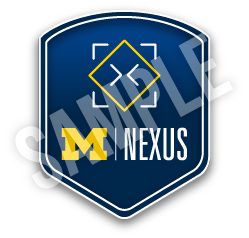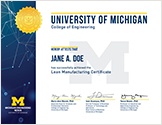SIX SIGMA CERTIFICATIONS
Design for Six Sigma - Green Belt
Home » Professional Education » Six Sigma Certifications » Design for Six Sigma – Green Belt
Key Information
Course Dates
Time Commitment
Approximately 60 self-paced hoursNot ready to commit?
Subscribe for email updates on future offerings and get a program brochure.
SIX SIGMA CERTIFICATIONS
Submit info below and we’ll email you our Six Sigma program brochure.
By submitting this form, you are consenting to receive marketing emails from Nexus. You may unsubscribe at any time.
By clicking 'Get Program Information' you are agreeing to receive emails from Nexus.
Earn your DFSS Green Belt from the University of Michigan. 100% online.
It is estimated that 70-80% of quality problems originate in product definition and design. The Design for Six Sigma (DFSS) methodology aims to preempt those problems by translating customer requirements into functional requirements — ensuring more robust product, service, and process designs. Learn proven analysis tools, apply those methods within a structured framework, and earn your Green Belt certification prepared to meet customer-driven design objectives.
LEARNING OBJECTIVES
- Understand the tools and techniques required to obtain voice of the customer and translate into functional requirements and quality metrics for designs during new product development
- Assess performance of functional requirements and quality metrics, including techniques for optimization and validation
- Understand tools to generate and select among design concept alternatives
- Apply statistical and graphical analysis tools to support testing and evaluation of designs
- Apply Design for Six Sigma Methods toward the development of new products and services at the Green Belt skill level
PROGRAM OVERVIEW
The DFSS Green Belt course is comprised of 24 modules which are detailed below:
- Course Introduction—New Product Development Challenges
- IDDOV Methodology/ Identifying Projects
- Defining Customer Requirements: Voice of the Customer
- Survey Analysis Methods
- Developing Functional Requirements/FAST Diagrams
- House of Quality
- Benchmarking
- Design Concept Generation
- Creativity and Innovation Tools
- TRIZ Overview
- Design Concept Selection: Design Scorecards, Pugh Matrix
- Design Failure Mode and Effects Analysis (DFMEA)
- Design Issue Countermeasures, DFX Analysis, Axiomatic Design
- Design Optimization: Transfer Functions, P-Diagrams, and Robustness
- Two Group Hypothesis Tests (t-test, F-test, 2 Proportion Tests)
- One Way ANOVA Tests
- Two Way ANOVA Tests
- Problem Solving Session: Hypothesis Tests
- Tolerance Analysis: Statistical Tolerance Methods
- Tolerance Simulation: Development and Allocation
- Problem Solving Session: Tolerance Simulation
- Product Design Verification and Validation
- Process Validation
- Course Summary
Estimated: 60 self-paced hours
- 40 hours (approximately) for lecture recordings and exercises
- 10-30 hours for project work
All requirements must be completed within 180 days after your start date. If you do not complete the course within one year of your start date, you will be required to re-enroll at a reduced cost of $500.
This is a self-paced online course consisting of 24 lecture modules with 8 exercises (multiple choice tests to complete after each learning module). Most lecture tapes are approximately one hour in length. While the course is self-paced, we recommend completing two sessions/week.
To earn the DFSS Green Belt certification, candidates must complete a project using the Identify-Define-Design (IDD) Six Sigma Methodology. This includes conducting an IDD analysis to translate the voice of the customer requirements into a new design concept using Design for Six Sigma tools and methods covered in the course.
Candidates should select a project from their workplace. If unable to find a work project, candidates may use a University of Michigan Green Belt Case Study Project.
Participants pursuing their University of Michigan Design for Six Sigma Green Belt Certification are required to:
- Complete all required online lecture modules
- Complete all testing exercises with an overall cumulative score > 80%
- Successfully complete DFSS Green Belt Project (reviewed by U-M faculty)
Upon successful completion, you will be provided your University of Michigan Design for Six Sigma Sigma Green Belt Certification.
A basic understanding of statistical analysis methods is recommended, including:
- Basic Microsoft Excel Skills
- Basic Statistics
To view technical requirements, click here.
Administrative/Online Technical Support
Support staff are available via phone and email to help with administrative and technical issues during our normal business hours (Monday through Friday 8:00 a.m. to 5:00 p.m. Eastern Time).
Content Questions/Certification Project Support
Candidates are welcome to contact the course instructors for content questions and project support. The instructors will provide support via e-mail, phone consultation, and/or online videoconferencing.
Who Should Take This Course
Design for Six Sigma Green Belt is aimed primarily at Product Designers, Manufacturing Engineers, and Project Managers working in new product development.
COMPLIMENTARY SOFTWARE
The University of Michigan DFSS Green Belt Certification course include a copy of QE Tools statistical analysis software. QE Tools is a user-friendly Excel add-in tool designed for Green Belts. Students will use QE Tools to apply the various problem solving and statistical analysis methods both within the course and for their DFSS project.
Six Sigma Content Subscription
Interested in maintaining access to course materials after you earn your certification? Purchase a 1-year Six Sigma Content Subscription and retain access to your Canvas account.
INSTRUCTIONAL TEAM

Pat Hammett, PhD
- Lead Faculty, Six Sigma Programs
- Associate Chair of Masters Education, Integrative Systems + Design
- Lecturer, College of Engineering

Don Lynch, PhD
- Instructor, Nexus
- Vice President of Quality, Strategy, and Transformation, SKF USA Inc.
What's Next?
CERTIFICATE
Design for Six Sigma - Black Belt
Preempt quality problems by translating customer requirements into functional requirements.
CERTIFICATE
Master Black Belt in Operational Excellence
Gain program management and technical problem-solving skills to be an effective continuous improvement leader.

